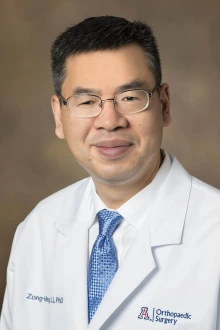Li Receives National Recognition for Discoveries in Hand Biomechanics
Dr. Zong-Ming Li of the UArizona College of Medicine – Tucson has been honored by the American Society of Mechanical Engineers for his work on human hands.
Zong-Ming Li, PhD, a professor of orthopaedic surgery and director of the Hand Research Laboratory at the University of Arizona College of Medicine – Tucson, has been selected by the American Society of Mechanical Engineers to receive the 2022 Savio L-Y. Woo Translational Biomechanics Medal for his work on human hands.
According to the American Society of Mechanical Engineers, the Savio L-Y. Woo Translational Biomechanics Medal recognizes an individual who has translated meritorious bioengineering science to clinical practice through research, education, and professional development, and with service to the bioengineering community.

Zong-Ming Li, PhD, is a professor of orthopaedic surgery and director of the Hand Research Laboratory at the UArizona College of Medicine – Tucson.
For Dr. Li, receiving an award named after Savio L-Y. Woo is especially meaningful. Early in his career, Dr. Li spent time in Dr. Woo’s Musculoskeletal Research Center at the University of Pittsburgh.
“Dr. Woo is a giant in orthopedic sports medicine and bioengineering. I learned from him to focus on a clinical problem, run a lab, serve the profession and mentor future generations,” recalled Dr. Li, who also is the William and Sylvia Rubin Endowed Chair in Orthopaedic Research and holds a joint appointment in biomedical engineering at the UArizona College of Engineering.
The medal will be presented at the Summer Biomechanics, Bioengineering, and Biotransport Conference in June, where Dr. Li will deliver a presentation on his work.
Dr. Li looks at the hand and wrist through an engineer’s lens to understand how they work and develop engineering solutions to problems such as carpal tunnel syndrome. According to the American Academy of Family Physicians, approximately 3% of adults have carpal tunnel syndrome, which is characterized by tingling, numbness or weakness in the affected hand.
Finding nonsurgical solutions
“The Hand Research Laboratory’s mission is to understand how the normal hand works and how to fix the hand when its function is disturbed,” Dr. Li said. “As an engineer, it is so interesting to study the human body — in our case, the complexity of the hand and wrist.”
The carpal tunnel is a space in the wrist through which the median nerve travels from the arm into the hand, passing under the transverse carpal ligament. If the ligament pushes against and irritates the nerve, it can cause carpal tunnel syndrome.
The condition may be initially treated with physical therapy, wrist splints or corticosteroid injections. If those strategies fail, doctors may recommend carpal tunnel release surgery to relieve the ligament’s pressure on the nerve. The surgery may also result in a weakened grip, though, and in some patients, carpal tunnel syndrome can return.
“In the U.S., a half-million people are getting surgery each year, but it is not a perfect solution,” said Dr. Li, who also is the vice chair for research in the Department of Orthopaedic Surgery, associate director of the UArizona Arthritis Center and a member of the BIO5 Institute. “We asked, ‘Can we relieve the median nerve without surgery?’ That simple question has kept us busy for years.”
Dr. Li and his research team, along with colleagues at the Cleveland Clinic, have developed a device that intermittently compresses the ligament and causes it to bend in a way that reduces pressure on the adjacent nerve. In early trials, the wrist manipulation improved symptoms in participants.
Dr. Li said discovering how to manipulate the space in the carpal tunnel to make more room for the nerve is one of his proudest accomplishments because it has potential to help countless patients.
“To find this simple principle that nobody else in the field is thinking of – that’s exciting,” he said. “We want not only to understand clinical problems, but also find solutions. Bringing this translational work to fruition takes years of work.”
Dr. Li and his collaborators are seeking grants to advance to the next phase of investigation, where they hope to enroll patients at multiple sites across the country to test the effectiveness of the device on a larger scale and determine the optimal strategy for its use.
Contact
David Bruzzese
520-626-9722
dbruzzese@arizona.edu
Anna Christensen
520-626-9964
achristensen@arizona.edu

